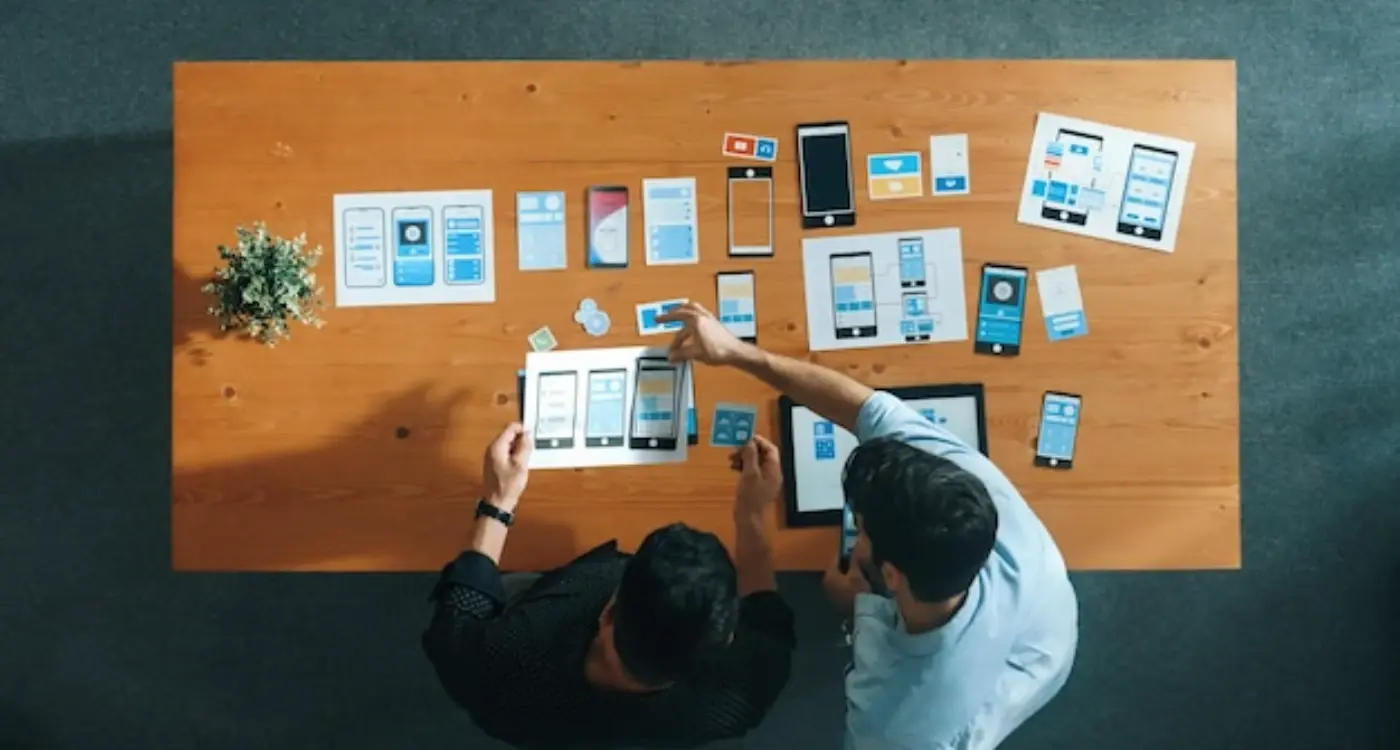What Makes Some Apps Easier to Build Than Others?
You've got this brilliant app idea that's been bouncing around your head for weeks, maybe months. You're excited, you can see exactly how it'll work, and you've even sketched out some rough designs on the back of a napkin. But then reality hits when you start talking to developers and get wildly different quotes—one agency says it'll take three months and cost £15k, another reckons six months and £40k. What's going on?
I've been on the receiving end of these conversations countless times over my years building apps, and honestly, the confusion is completely understandable. From the outside, apps can look deceptively similar—they're all just screens with buttons and text, right? But underneath that simple interface lies a web of technical decisions that can make the difference between a straightforward build and a proper headache.
The truth is, app complexity isn't always obvious from the user's perspective. An app that looks clean and simple might be doing incredibly complex things behind the scenes—think about how Uber manages real-time location tracking, payment processing, driver matching algorithms, and surge pricing calculations all whilst making it feel like you're just tapping a button to get a ride.
The most successful apps are often the ones that hide their complexity so well that users never realise how much work went into making something feel effortless
Understanding what makes some apps harder to build than others isn't just about managing expectations or getting better quotes from developers. It's about making smarter decisions during the planning phase, prioritising features that actually matter to your users, and avoiding those expensive technical rabbit holes that can derail projects. Let me walk you through exactly what separates the quick wins from the complex challenges in mobile app development.
Understanding App Complexity Basics
When clients come to me asking about their app idea, one of the first things we talk about is complexity. Not because I want to scare them off—quite the opposite actually. Understanding what makes an app simple or complex helps set realistic expectations for timeline, budget, and what we can achieve in version one.
Think of app complexity like building a house. A simple app is like a studio flat—one room, basic plumbing, standard electrical work. You can get it done quickly and it does exactly what it needs to do. A complex app? That's more like a smart home with automated everything, multiple floors, and custom features throughout. Both are houses, but the effort required is worlds apart.
What Actually Makes an App Complex?
The complexity isn't always obvious from the outside. I've had clients show me apps that look dead simple but are actually incredibly sophisticated under the hood. Others want something that looks fancy but is actually quite straightforward to build.
- Number of user types (regular users vs admins vs business owners)
- Data complexity—how much information needs storing and processing
- Real-time features like chat, live updates, or collaborative editing
- Integration requirements with other systems or services
- Custom algorithms or artificial intelligence features
- Security and compliance requirements
- Offline functionality and data synchronisation
The key thing to understand is that complexity compounds. Adding user accounts to a simple app isn't just one extra feature—it affects everything else. Suddenly you need login systems, password resets, user permissions, data privacy controls... it snowballs quickly. That's why we always start with the simplest version that delivers real value, then build from there.
Features That Make Development Simple
After years of building apps across every industry you can think of, I've noticed certain features just work brilliantly from a development perspective. They're straightforward to code, don't break easily, and users understand them immediately—which honestly makes everyone's life easier.
Static content screens are your best friend when it comes to simple development. Things like "About Us" pages, terms and conditions, or help sections require minimal backend work and practically never cause problems. Sure, they might not be the most exciting parts of your app, but they're reliable and quick to implement.
Basic forms are another area where development stays refreshingly simple. Contact forms, feedback screens, or simple registration pages use standard components that every developer knows inside and out. The complexity only creeps in when you start adding real-time validation, multi-step processes, or fancy animations—but the core functionality? Dead simple.
User Interface Elements That Just Work
Standard navigation patterns like tab bars, side menus, and simple button layouts are tried and tested for good reason. They follow platform conventions that users already understand, which means less custom code and fewer usability issues. I mean, why reinvent the wheel when the wheel works perfectly fine?
List views displaying simple data are another developer favourite. Whether it's showing products, articles, or user profiles, basic lists use native components that handle scrolling, loading, and performance automatically. The magic happens when you keep the data structure straightforward—no complex relationships or nested categories to worry about.
Start with these simple features first when planning your app. They'll give you a solid foundation and help you understand your project's scope before tackling the more complex functionality.
When Things Get Complicated
Right, so we've covered the straightforward stuff—but what happens when your app idea starts getting a bit more ambitious? This is where things can get properly tricky, and honestly, its where I see a lot of projects go sideways if we don't plan things out carefully.
Real-time features are usually the first thing that'll make your developer's eye twitch a bit. Chat functions, live tracking, collaborative editing—these all need constant communication between your app and the server. Its like trying to have a conversation where everyone's talking at once; you need proper systems to make sure messages don't get lost or arrive in the wrong order.
The Big Complexity Culprits
Here's what typically turns a simple project into a proper headache:
- Custom animations and complex user interfaces that need to work smoothly on different devices
- Offline functionality that syncs data when you're back online
- Payment processing with multiple currencies and security requirements
- Video or audio streaming that doesn't buffer every five seconds
- Machine learning features that actually work reliably
- Multi-user systems where people can collaborate or compete
The thing about complex features is they don't just add development time—they multiply it. Adding a simple chat feature might seem straightforward, but then you need message encryption, user blocking, media sharing, push notifications, and suddenly your "simple" chat has become a mini WhatsApp.
Security becomes a much bigger concern too. The more data you're handling and the more complex your app becomes, the more potential entry points there are for things to go wrong. You know what? Sometimes the smartest thing is to start simple and add complexity later, rather than trying to build everything at once.
Platform Differences and Their Impact
Right, let's talk about something that catches a lot of people off guard—how different iOS and Android really are under the hood. I mean, you'd think they're basically the same thing with different colours, but honestly? They're like two completely different worlds when it comes to development complexity.
iOS development tends to be more straightforward in some ways. Apple controls everything—the hardware, the operating system, even which devices your app needs to work on. There's maybe a dozen different iPhone models to worry about, and they all behave pretty predictably. The development tools are solid, the documentation is decent, and if something goes wrong it's usually easier to figure out why.
Android is... well, it's a different beast entirely. You've got thousands of different devices, each with their own quirks and specifications. Samsung phones behave differently from Google Pixels, which behave differently from budget handsets. It's genuinely mad how much testing you need to do just to make sure your app doesn't crash on someone's two-year-old phone.
The biggest mistake I see clients make is assuming their app will work the same way on both platforms—it never does, and planning for those differences from day one can save you months of headaches later.
But here's where it gets interesting—sometimes Android is actually easier to work with. Want to access files? Easy. Need to integrate with other apps? No problem. iOS has much stricter rules about what your app can and can't do, which means more workarounds and creative solutions when you're trying to build something that pushes boundaries.
The real kicker? Users expect your app to feel native on their platform. iOS users want gestures and animations that feel like Apple designed them; Android users expect material design and navigation patterns they're used to. Building one app that feels right on both platforms? That's where development complexity really starts to ramp up, especially when dealing with enterprise security challenges across platforms.
The backend is where most apps either become simple projects or turn into proper headaches. I mean, some apps barely need a backend at all—think of a simple calculator or a basic photo editing tool that works entirely on your phone. But the moment you want users to create accounts, save data, or share content with others, you're looking at server infrastructure, databases, and all the complexity that comes with it.
Actually, the real complexity often comes from what happens to your data after users create it. A basic app might just store a user's preferences locally on their device. Simple stuff. But if you want those preferences synced across multiple devices? Now you need cloud storage, user authentication, and data synchronisation logic. And don't get me started on what happens when two devices try to update the same information at the same time—conflict resolution can be a proper nightmare.
Here's what really separates simple backends from complex ones:
- User accounts and authentication systems
- Real-time features like chat or live updates
- File uploads and media processing
- Complex business logic and calculations
- Integration with payment systems
- Data analytics and reporting features
The type of data you're handling makes a massive difference too. Storing simple text entries? Not too bad. But if you're dealing with images, videos, or sensitive financial information, you'll need proper file storage systems, content delivery networks, and serious security measures. GDPR compliance alone can add weeks to a project when you're handling personal data properly.
One thing I always tell clients is that real-time features are complexity multipliers. A simple messaging app becomes much more involved when you want messages to appear instantly across devices. You'll need websockets, message queuing systems, and robust error handling for when connections drop.
Third-Party Integrations and APIs
Right, let's talk about third-party integrations—because honestly, this is where a lot of app projects go from "straightforward" to "bloody complicated" faster than you can say API documentation. I've seen simple app ideas balloon into complex beasts just because someone decided they needed to connect to seventeen different services.
The thing is, integrations can actually make development easier if you choose them wisely. Need payment processing? Stripe's API is genuinely brilliant and well-documented. Want user authentication? Firebase Auth can save you weeks of development time. But here's where it gets tricky—not all APIs are created equal, and some are frankly a nightmare to work with.
I always tell clients that every integration adds a potential point of failure to their app. Sure, connecting to social media platforms or mapping services might seem straightforward, but what happens when Facebook changes their API (again) or Google decides to deprecate a feature you're relying on? Your app complexity shoots up because now you're at the mercy of external systems.
Before committing to any third-party service, spend time reading their documentation and checking their API versioning policy. Well-maintained APIs with clear upgrade paths will save you headaches down the road.
Common Integration Complexity Levels
- Simple: Payment processors (Stripe, PayPal), basic social login, push notifications
- Moderate: CRM systems, email marketing platforms, analytics tools
- Complex: Legacy enterprise systems, custom APIs, real-time data feeds
- Hair-pulling: Banking APIs, healthcare systems, government databases
The key is being selective. Each integration needs to justify its existence because you're essentially making your app dependent on another company's technical decisions. Sometimes building something custom is actually less risky than relying on a third-party service that could change or disappear tomorrow.
Testing and Quality Assurance Factors
Right, let's talk about testing—because honestly, this is where simple apps stay simple and complex ones can become proper nightmares. The amount of testing your app needs directly affects how much time and money you'll spend on development.
A basic calculator app? You're testing maybe twenty functions across two platforms. Job done. But a banking app with biometric authentication, real-time transactions, and offline capabilities? You're looking at thousands of test cases and months of quality assurance work.
What Makes Testing More Complex
Some features just demand more thorough testing than others. Payment processing, for instance—you can't just check it works once and call it a day. You need to test every possible scenario: failed payments, network dropouts, timeout errors, different card types, international currencies... the list goes on.
Then there's device compatibility. A simple news app might work fine on most phones with basic testing. But if you're building something that uses camera features, GPS, or hardware sensors, you need to test on dozens of different devices because—and this drives me mad—they all behave slightly differently.
Types of Testing That Add Complexity
- Security testing for apps handling sensitive data
- Performance testing under heavy user loads
- Cross-platform compatibility testing
- Integration testing with third-party services
- Accessibility testing for inclusive design
- Offline functionality testing
The thing about quality assurance is you can't really cut corners—not if you want your app to succeed. Users will abandon apps that crash or behave unexpectedly faster than you can say "one-star review." So when planning your app, remember that complex features don't just take longer to build; they take significantly longer to test properly too.
Conclusion
After building hundreds of apps over the years, I can tell you that app complexity isn't something you should fear—it's something you need to understand and plan for properly. The difference between an easy build and a nightmare project usually comes down to how well you've thought things through at the start.
Simple apps work because they focus on doing one thing really well. They don't try to be everything to everyone, they use proven technologies, and they keep the user journey straightforward. Complex apps become problematic when they try to solve too many problems at once or when clients haven't properly mapped out what they actually need versus what they think would be "nice to have."
The key factors we've covered—features, platform choices, backend requirements, integrations, and testing—all interact with each other. Add real-time functionality to a simple app? You've just increased your development difficulty significantly. Want to sync data across multiple platforms? That backend complexity will affect your timeline and budget whether you like it or not.
But here's the thing I always tell my clients: complex doesn't mean impossible. It just means you need more time, more budget, and frankly, more expertise to get it right. Some of the most successful apps I've built have been technically complex but they succeeded because we planned properly, set realistic expectations, and built them in phases.
Before you start any app project, take a step back and honestly assess what you're trying to build. Understanding your app's complexity from day one will save you time, money, and a lot of headaches down the road. Trust me on this one—I've seen what happens when people don't!
Share this
Subscribe To Our Learning Centre
You May Also Like
These Related Guides

How Long Does It Take To Develop A 5G Mobile App?

How Do You Create a Distinctive App Value Proposition?



